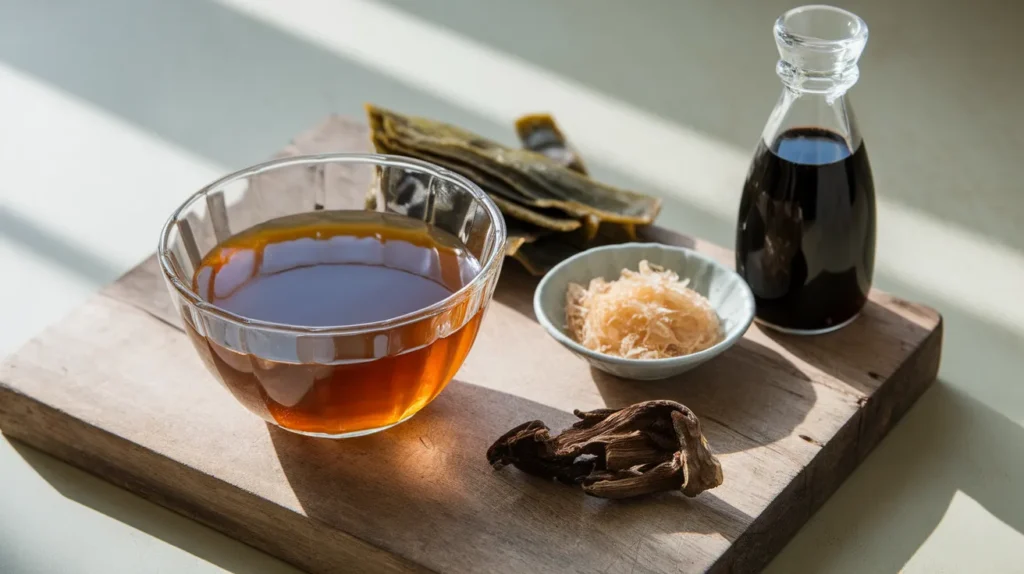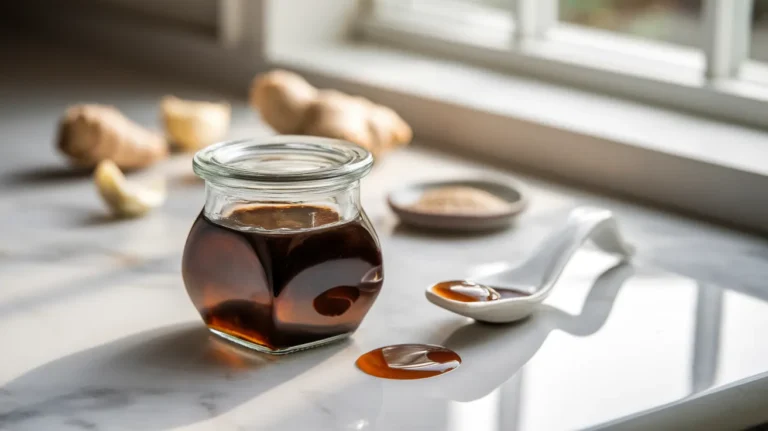This authentic Mentsuyu sauce recipe transforms your kitchen into a Japanese culinary haven with simple, accessible ingredients. Our step-by-step Mentsuyu sauce guide ensures even first-time cooks can master this essential Japanese condiment that elevates everything from cold soba noodles to hot udon bowls.
SERVES: 4 | PREP: 20 MIN | COOK: 15 MIN | TOTAL: 35 MIN
What You’ll Need for Perfect Mentsuyu Sauce
| Base Ingredients | Amount |
|---|---|
| Japanese soy sauce (shoyu) | 1/2 cup |
| Mirin (sweet rice wine) | 1/4 cup |
| Sake (cooking wine) | 2 tablespoons |
| Filtered water | 1/4 cup |
| Umami Builders | Amount |
|---|---|
| Kombu seaweed (dried) | 1 piece (4-inch) |
| Bonito flakes (katsuobushi) | 1/2 cup |
| Dried shiitake mushrooms | 3 pieces |
| Flavor Balance | Amount |
|---|---|
| Granulated sugar | 2 tablespoons |
| Fine sea salt | 1/4 teaspoon |
Complete Step-by-Step Mentsuyu Sauce Instructions
Phase 1: Ingredient Preparation (8 minutes)
Step 1: Prepare Your Kombu Seaweed Take your dried kombu piece and examine it carefully. You’ll notice a white, powdery coating – this is natural sea salt and umami compounds, not dirt. Using a barely damp paper towel, gently wipe the surface to remove excess salt while leaving most of the white coating intact. Never rinse kombu under running water as you’ll wash away precious flavor compounds that make your Mentsuyu sauce authentic. Set the cleaned kombu aside on a clean plate.
Step 2: Inspect and Prepare Shiitake Mushrooms Look at your dried shiitake mushrooms – they should feel completely dry and have a deep, earthy aroma. If they smell musty or show any signs of mold (fuzzy patches), discard them immediately. Good dried shiitakes will be firm and have a rich brown color. Give them a very quick rinse under cold water (2-3 seconds maximum) to remove any surface dust, then pat completely dry with paper towels. This brief rinse won’t affect their ability to infuse flavor into your sauce.
Step 3: Set Up Your Workspace Clear your counter space and arrange all ingredients within easy reach. Place a fine-mesh strainer over a clean bowl – you’ll need this ready for later. Have your measuring cups clean and dry. This organization prevents mistakes when you’re focused on timing during the cooking process.
Step 4: Check Your Bonito Flakes Open your package of bonito flakes and examine them. Fresh katsuobushi should look like delicate wood shavings with a pinkish-brown color and smell like the ocean with a hint of smokiness. If they smell fishy or sour, they’re past their prime and will create off-flavors in your Mentsuyu sauce. Good bonito flakes will be dry and crumble slightly when touched.
Phase 2: Creating the Dashi Foundation (10 minutes)
Step 5: Start the Cold Infusion In your medium saucepan, combine the 1/4 cup filtered water, the cleaned kombu piece, and all 3 dried shiitake mushrooms. The water should just barely cover the kombu – if it doesn’t, add water one tablespoon at a time until it does. Let this mixture sit at room temperature for exactly 3 minutes. During this time, you’ll notice the kombu beginning to soften slightly and the shiitakes starting to absorb water. This cold infusion begins extracting flavors gently, preventing the bitterness that can occur with rapid heating.
Step 6: Begin Gentle Heating Place your saucepan over the lowest possible heat setting on your stove. If you have an electric stove, use the smallest burner. The goal is to heat the water so slowly that it takes about 8-10 minutes to reach a gentle simmer. You should see tiny bubbles forming on the bottom of the pan first, then small bubbles rising to the surface around the edges. Crucial timing note: Watch the kombu carefully – when it starts floating to the surface and moving freely in the water, it’s ready to remove.
Step 7: Remove Kombu at the Perfect Moment When you see the kombu floating and the water just beginning to show small bubbles around the edges (this is about 185°F if you have a thermometer), immediately remove the kombu with tongs or a fork. Don’t let it boil – boiling kombu creates a slimy texture and bitter flavor that will ruin your Mentsuyu sauce. The kombu should feel soft and slightly slippery when you remove it. Save it for another use or discard it.
Step 8: Add Bonito Flakes Properly Remove the saucepan from heat completely. Add all 1/2 cup of bonito flakes to the hot liquid in one motion – they should dance and swirl as they hit the surface, then gradually settle. Do not stir at this point. The flakes will naturally distribute themselves. Let them steep for exactly 3 minutes. You’ll see the liquid beginning to take on a golden color and develop a rich, oceanic aroma.
Step 9: Strain Your Dashi Base Line your fine-mesh strainer with a clean kitchen towel or several layers of cheesecloth. Slowly pour the entire mixture through the strainer into your clean bowl. Let gravity do the work for about 2 minutes. Then, very gently press the bonito flakes and mushrooms with the back of a spoon to extract more liquid, but don’t squeeze hard – aggressive pressing releases bitter compounds. You should have about 1/3 cup of clear, golden dashi. If it’s cloudy, strain it again through coffee filters.
Phase 3: Building Your Mentsuyu Sauce (5 minutes)
Step 10: Combine Liquid Ingredients Return your strained dashi to the clean saucepan. Add the 1/2 cup Japanese soy sauce – notice how the color deepens to a rich amber. Add the 1/4 cup mirin and 2 tablespoons sake. Stir gently with a wooden spoon (metal spoons can react with acidic ingredients). The mixture should smell complex – salty, slightly sweet, and deeply savory.
Step 11: Dissolve Sugar and Salt Add the 2 tablespoons sugar and 1/4 teaspoon salt to the liquid. Stir continuously until you can no longer see any granules – this usually takes about 30 seconds. Taste the mixture carefully (it will be salty at this point) – you should detect sweetness balancing the saltiness, with deep umami flavors in the background.
Step 12: Final Cooking Phase Place the saucepan over medium-low heat. You want to bring the mixture to a very gentle simmer – just a few lazy bubbles breaking the surface. This should take about 2-3 minutes. Once simmering, cook for exactly 2 minutes to cook off the harsh alcohol flavors from the sake and mirin. You’ll notice the aroma becoming rounder and less sharp. Don’t let it boil vigorously – this can make the sauce taste harsh.
Step 13: Cool and Final Taste Test Remove from heat and let the Mentsuyu sauce cool to room temperature – this takes about 10 minutes. As it cools, the flavors will meld and develop complexity. Taste again when cool – it should be savory-sweet with a clean finish and no harsh alcohol bite. The sauce should coat a spoon lightly but not be thick or syrupy.
Phase 4: Final Adjustments (2 minutes)
Step 14: Perfect Your Balance If your Mentsuyu sauce tastes too salty, add 1/2 teaspoon more mirin. If it’s too sweet, add 1/2 teaspoon more soy sauce. If it lacks depth, let it rest for 30 minutes – the flavors continue developing. The perfect Mentsuyu sauce should taste balanced with no single flavor dominating.
Chef’s Professional Notes for Mentsuyu Sauce Success
• Ingredient quality transforms your sauce – Japanese soy sauce (shoyu) has a cleaner, more complex flavor than Chinese varieties, making your Mentsuyu sauce taste authentically restaurant-quality.
• Temperature control prevents bitterness – Keep all heating gentle and watch timing carefully. Rushed Mentsuyu sauce often tastes harsh or bitter.
• Fresh bonito flakes make the difference – Old katsuobushi creates fishy flavors instead of clean umami depth in your homemade Mentsuyu sauce.
• Resting time improves flavor – Your Mentsuyu sauce will taste significantly better after sitting overnight as all the flavors marry and develop complexity.
Nutrition Information (Per Serving)
- Calories: 42
- Protein: 3g
- Carbohydrates: 8g
- Fat: 0g
- Sodium: 1,180mg
- Sugar: 6g
Creative Mentsuyu Sauce Variations
Spicy Heat Version
Add 1 teaspoon Japanese chili oil (rayu) and 1/4 teaspoon togarashi during the final simmering. This creates warming heat perfect for cold winter noodles.
Rich Mushroom Mentsuyu
Double the shiitake mushrooms and add 1 tablespoon mushroom powder for deeper earthiness. This variation pairs beautifully with our yakitori sauce for grilled dishes.
Citrus-Bright Style
Finish your cooled Mentsuyu sauce with 1 tablespoon fresh yuzu juice or meyer lemon juice. The acidity brightens every flavor note.
Restaurant-Style Concentrate
Reduce water by half and simmer 2 minutes longer for a more intense version. Dilute when serving, similar to how tentsuyu sauce concentrates are used for tempura.
Storage & Reheating Your Mentsuyu Sauce
Refrigerator storage: Store your Mentsuyu sauce in airtight glass containers for up to 2 weeks. The flavors actually improve after the first day as they continue developing.
Freezer option: Pour into ice cube trays for perfect single-serving portions. Frozen Mentsuyu sauce cubes last 3 months and thaw perfectly.
Using cold: Most traditional applications use Mentsuyu sauce at room temperature or chilled for cold noodle dishes.
Gentle reheating: Warm in a small saucepan over low heat, stirring occasionally. Never microwave as it can create hot spots that alter the flavor balance.

Troubleshooting Your Mentsuyu Sauce
Problem 1: Sauce tastes overwhelmingly salty Solution: Add 1 tablespoon mirin and 1 teaspoon sugar gradually until balanced. Always taste between additions. You can also dilute with a small amount of fresh dashi.
Problem 2: Bitter or harsh flavors developed Solution: This comes from overheating kombu or boiling too vigorously. Unfortunately, bitterness can’t be removed – start over with gentler heat control throughout the process.
Problem 3: Sauce appears cloudy or murky Solution: Strain through coffee filters twice for crystal clarity. Cloudiness comes from pressing bonito flakes too hard or boiling instead of simmering.
Problem 4: Lacks the deep umami flavor Solution: Let your Mentsuyu sauce rest overnight in the refrigerator. If it’s still flat, your bonito flakes may be old – fresh katsuobushi is essential for proper flavor development.
Problem 5: Too thin or watery consistency Solution: Simmer uncovered for 1-2 additional minutes to concentrate flavors and reduce liquid. Add 1/2 teaspoon cornstarch mixed with cold water if you need more body.
Essential Equipment for Mentsuyu Sauce
- Medium heavy-bottomed saucepan (2-quart capacity prevents scorching)
- Fine-mesh strainer (essential for clear sauce)
- Clean kitchen towels or cheesecloth (for crystal-clear straining)
- Glass storage jars (won’t absorb flavors like plastic)
- Wooden spoon (won’t react with acidic ingredients)
- Kitchen timer (precise timing prevents mistakes)
Organized Shopping List for Mentsuyu Sauce
Asian Grocery Section
- Kombu seaweed (dried sheets)
- Bonito flakes (katsuobushi in packages)
- Japanese soy sauce (shoyu brand preferred)
- Mirin (hon-mirin if available)
- Cooking sake
Dried Goods Section
- Dried shiitake mushrooms
Basic Pantry Items
- Granulated sugar
- Fine sea salt
Expert Success Secrets for Perfect Mentsuyu Sauce
1. Invest in authentic Japanese ingredients – Real mirin, quality soy sauce, and fresh bonito flakes create Mentsuyu sauce that rivals restaurant versions.
2. Master gentle heat control – Every step requires patience and low temperatures to extract flavors without bitterness in your Mentsuyu sauce.
3. Time each step precisely – Steeping times and heating phases are crucial for proper flavor development.
4. Taste and adjust gradually – Build the perfect balance of salty, sweet, and umami flavors slowly.
5. Allow overnight resting – Your Mentsuyu sauce transforms dramatically after the flavors marry for 12-24 hours in the refrigerator.




